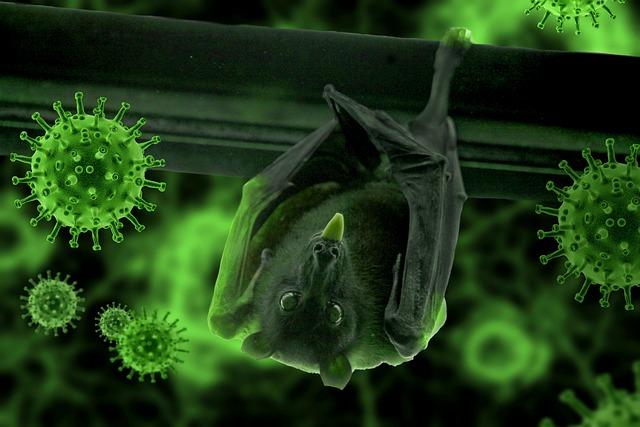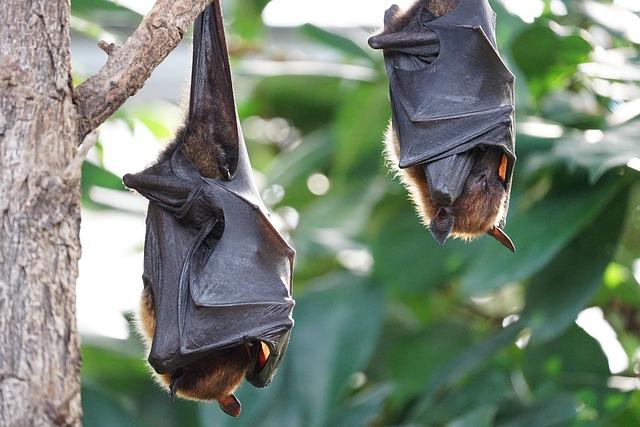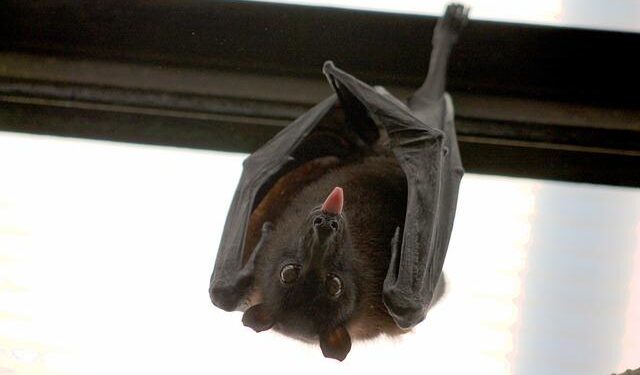In recent weeks, the detection of a new bat coronavirus in China has sparked significant concern among health officials and researchers worldwide. As the world continues to grapple with the repercussions of the COVID-19 pandemic, this emerging pathogen serves as a stark reminder of the ongoing threats posed by zoonotic diseases—viruses that can leap from animals to humans. With wildlife markets,changing ecosystems,and human encroachment into natural habitats creating ripe conditions for such viruses to spread,experts are closely monitoring this advancement. In this article, we explore the implications of this new coronavirus, its potential to trigger a future outbreak, and the urgent measures needed to mitigate the risks associated with emerging infectious diseases.
Emergence of a New Bat Coronavirus in China and Its Implications for Global Health

The revelation of a new bat coronavirus in China has sent ripples through the global health community, reigniting fears of potential outbreaks and pandemics. With coronaviruses being notorious for their capacity to jump from animals to humans, this latest strain has raised alarms due to its genetic similarities to previous pathogens. Key factors contributing to the concern include:
- High transmission rates observed in animal populations.
- Potential mutations that could enhance its infectivity in humans.
- Increased human-bat interactions due to changes in land use and urbanization.
Health experts emphasize the need for vigilant monitoring and rapid response strategies. Understanding this virus’s ecological and evolutionary dynamics is crucial for anticipating its behavior and mitigating risks associated with zoonotic spillover. To aid in comprehension, the following table summarizes the potential implications for public health:
| implication | Description |
|---|---|
| Increased Surveillance | Enhanced monitoring of wildlife and human populations to identify and contain outbreaks early. |
| Research Funding | Allocation of resources for studies related to zoonotic diseases and vaccine development. |
| Public Awareness | Educating communities on preventing wildlife-related disease transmission. |
Understanding the Genetic Makeup of the New virus and Its Potential Risks

The recent discovery of a new bat coronavirus has sent researchers into a flurry of activity as they seek to understand its genetic composition and the implications for public health. Genomic sequencing reveals a range of mutations that enhance the virus’s ability to infect hosts, suggesting a high degree of adaptability. Key features of the virus include:
- Spike Protein Variability: Alterations in the spike protein may increase attachment to human cell receptors.
- Replication Rates: Faster replication rates observed could led to quicker spread among populations.
- Potential Zoonotic Transmission: Close genetic links to existing coronaviruses raise concerns about spillover events from animals to humans.
Understanding the genetic makeup of this virus is critical not only for tracking its evolution but also for developing potential treatments or vaccines. Researchers are focusing on the following areas to assess the risks involved:
| Risk Factor | Assessment |
|---|---|
| Mutation Rate | High |
| Human Transmission Potential | Moderate |
| Existing Immunity Levels | Low |
This concerted focus on the virus’s genome is imperative for anticipating future outbreaks and equipping healthcare systems with the necessary tools to combat a possible pandemic. Early warning systems and collaborative research efforts will play vital roles in mitigating risks associated with emerging viruses.
The Role of Wildlife Markets in Viral Transmission and Preventative measures

Wildlife markets have long been a focal point for researchers studying zoonotic diseases, as they serve as a bridge between wildlife and human populations. The close quarters of various species—frequently enough under stressed and unsanitary conditions—facilitates the potential for viruses to spill over from animals to humans. In particular, bats, being natural reservoirs for many coronaviruses, pose a significant risk when they are confined in proximity to other species, including domesticated animals and humans.Such interactions can significantly increase the chances of viral mutations, wich may lead to new strains that can jump to humans, exacerbating the risks of outbreaks.
To mitigate these risks, experts advocate for a multi-faceted strategy involving both local and global action. Some preventative measures include:
- Implementing stricter regulations on wildlife trade
- Enhancing surveillance and monitoring of wildlife health
- promoting public awareness campaigns about the risks of wildlife consumption
- Encouraging choice livelihoods for communities dependent on wildlife markets
Governmental agencies, NGOs, and international organizations must collaborate to ensure the enforcement of these measures, aiming to create safer environments that minimize human exposure to potential pathogens.
Collaborative Efforts in Surveillance and Research: A Call to Action for scientists and Policymakers

The recent discovery of a new bat coronavirus in China underscores the urgent need for enhanced collaborative efforts between scientists and policymakers globally. The emergence of this virus raises multiple questions regarding transmission pathways, zoonotic potential, and the efficacy of existing surveillance systems. as we confront these challenges, it is imperative that we foster interdisciplinary partnerships that integrate expertise in virology, epidemiology, public health, and environmental sciences. Such collaborations can facilitate a more extensive understanding of emerging infectious diseases and allow for rapid response strategies that prioritize both human and wildlife health.
To achieve this, stakeholders must focus on several core initiatives:
- Data Sharing: Establishing robust frameworks for sharing genomic and epidemiological data across borders will enhance our understanding of viral evolution and spread.
- Joint Research Funding: Policymakers should incentivize joint funding programs that support cross-disciplinary research projects, fostering innovations in disease detection and prevention.
- Capacity Building: Investing in training local scientists and health officials in surveillance techniques can improve responsiveness to potential outbreaks before they escalate.
| Focus Area | Proposed Action |
|---|---|
| Virological Research | Enhanced focus on zoonotic pathogens |
| Surveillance Systems | Improved data collection and analysis |
| Public Communication | Clear messaging on risks and prevention |
Public Health Preparedness: Ensuring Readiness for Potential Outbreaks

The emergence of a new bat coronavirus in China underscores the urgent need for robust public health strategies that enable swift responses to potential viral outbreaks. As zoonotic diseases continue to pose significant threats, preparedness plans must evolve to include not only rapid detection and containment but also comprehensive surveillance systems. Key components of effective preparedness include:
- Investment in Research: Continuous funding for virology studies helps in understanding virus mutations.
- Global Cooperation: Collaborative efforts between countries can enhance the sharing of critical data.
- Public Education: Frontline communities should be engaged with awareness initiatives about emerging health threats.
Furthermore, establishing a tiered response system can significantly enhance readiness.This involves preparing healthcare facilities with necessary resources and training, ensuring adequate stockpiles of medical supplies, and implementing effective communication strategies across all levels of public health infrastructure. Strategies to consider include:
| Category | Action | Responsibility |
|---|---|---|
| Vaccination | Develop and deploy effective vaccines | Public Health Authorities |
| Surveillance | Enhance monitoring systems for early detection | Research Institutions |
| Communication | Establish clear channels of information | Government Agencies |
Strategies for Mitigating Future Zoonotic Spillover Events and Protecting Human Health
In light of recent discoveries linking a new bat coronavirus to potential zoonotic spillover, proactive strategies are essential to mitigate the risks of future outbreaks. A multifaceted approach is crucial, encompassing enhanced surveillance of wildlife populations, improved biosecurity measures, and increased public health readiness.to achieve this, stakeholders must collaborate across various sectors, including health, agriculture, and wildlife conservation. Key initiatives should include:
- Wildlife Monitoring: Implementing robust surveillance systems that track virus prevalence in animal reservoirs.
- Community Engagement: Educating local populations about avoiding contact with wildlife and recognizing signs of emerging diseases.
- Research Funding: Allocating resources for studying zoonotic pathogens, particularly those originating from bats and other wildlife.
- Cross-Sector Collaboration: fostering partnerships between scientists, policymakers, and healthcare providers to streamline response strategies.
Additionally, strengthening international cooperation is vital for controlling zoonotic diseases. Countries should establish a network for sharing data on emerging infectious diseases and best practices in managing wildlife-human interactions. Public health infrastructure must be fortified to respond swiftly to potential spillover events, minimizing the risk of widespread outbreaks. Here’s an overview of strategic priorities:
| Priority | Objective |
|---|---|
| Enhance Surveillance | Monitor wildlife for infectious agents continually. |
| promote Research | Investigate zoonotic transmission pathways and prevention strategies. |
| Strengthen Public Health | Develop rapid response plans for disease outbreaks. |
to sum up
the emergence of a new bat coronavirus in China poses significant implications for global public health. As researchers continue to investigate the virus’s origins, transmission dynamics, and potential risks to humans, it is essential for health authorities worldwide to remain vigilant.The lessons learned from previous outbreaks underscore the importance of early detection and swift response strategies to mitigate future threats. As the scientific community collaborates to understand and address this evolving challenge, international cooperation and robust surveillance systems will be key to safeguarding public health and preventing the spread of zoonotic diseases. The situation underscores the need for ongoing research and investment in health infrastructure to better prepare for whatever challenges may arise on the horizon.















